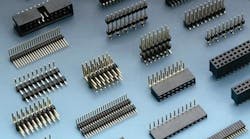The automotive industry is one of the hottest markets for interconnect products today, and electronics distributors are heeding the call to serve the industry’s diverse need for the latest technology and services. The drive to produce smarter, more energy-efficient and feature-rich vehicles is at the heart of the trend, creating an attractive market among those serving automakers and their ancillary service providers.
“We see automotive, through the second-tier relationships we have with customers, being a robust market,” says Steve Boysen, senior vice president and director of interconnect, passive and electromechanical (I,P &E) sales for Avnet Electronics Marketing Americas. “The electronics content within [automobiles] today is increasing at a fast rate—both on the processor and the interconnect sides of the business.”
Recent market forecasts also point to the automotive industry as a growth area for connectors. A late August connector outlook from industry analyst Ron Bishop, for example, pointed to strength in automotive, transportation, computer/peripheral, and commercial aviation markets through the summer. In his report for TTI Inc.’s Market Eye, Bishop noted that North American automotive demand for connectors will remain good in the second half of the year, while demand will slow in Europe and improve in China. Bishop’s data is based on interviews with connector company executives.
As distributors continue to focus on the growing need for advanced connector technology in automotive markets and elsewhere, they are also keeping a sharp eye on what’s driving those advances. Boysen points to advanced semiconductor technology and the resulting need for connectors to keep up with demands for higher speed and data rates. He also notes that advances in consumer products such as smart phones and tablet computers are driving advances in other industries.
“It all centers around the need to really keep up with the high data rates and speeds that semiconductor technology is pushing the envelope on,” notes Boysen. “Signal integrity continues to be a main focus for most of our customers, and it continues to be a focus for many of our suppliers—coming up with products and solutions that can meet those needs.”
Modest Growth Ahead
Bishop predicts modest 3.5% growth in the global connector market this year, helped by strong demand for speed and bandwidth in telecommunications and strong growth in automotive, transportation, and commercial aviation markets. Easy comparisons to the fourth quarter of 2011 will also help with year-over-year results.
Boysen predicts modest growth in the sector this year as well and says the medical and military markets also are performing well for Avnet EM Americas. Like the automotive industry, makers of medical equipment require more and more electronic components today, and advances in semiconductor technology are driving the need for smarter connectors there as well. In the military field, demand for unmanned aerial vehicles (UAVs) is a key source of growth, he says.
Value-added services for military and other markets are also helping to drive growth in connectors. Boysen points to Avnet’s value-added connector modification and assembly center in Nogales, Mexico, as one example. Up and running since 2010, the 125,000-square-foot facility features both an electronic component distribution center and a value-added assembly operation that processes custom connectors, cables, fans, and other electromechanical assemblies for the electronics industry.
“That’s an area where we’re doing a very significant degree of connector assembly—for the military especially,” Boysen adds.
The center feeds a growing demand for interconnect, passive, and electromechanical engineering services in general. Many customers, especially smaller ones, are finding themselves lacking in this area due to downsizing in recent years. As customers focus more of their attention on the software and semiconductor sides of the business, there’s a growing need for design support on the I,P & E side, Boysen says.
“The resource pool at the customer base is probably not as robust [on the interconnect side] as it is on the semiconductor side,” he explains. “There are still large companies that have resources around that, but smaller companies are asking us to step in, from an engineering perspective, to help with the interconnect side. Although the software phase differentiates their product, at some point they have to come back to the passive and interconnect part to make sure the system works.”








